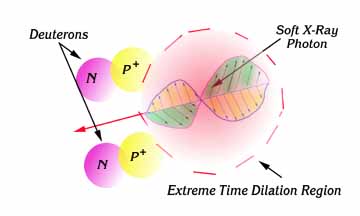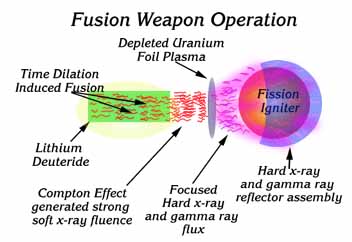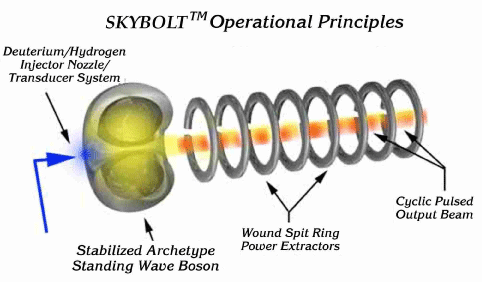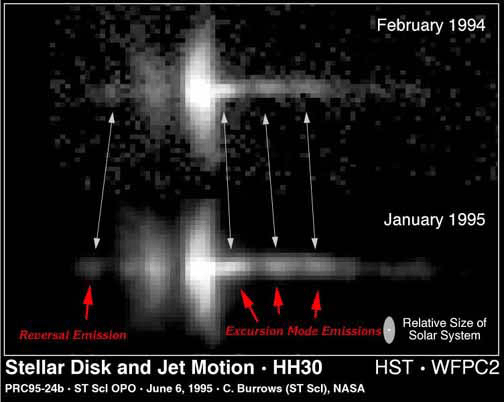The Physics of Successful FusionSince it is is evident from the General Case that nuclear fusion occurs between fuel nuclei only when they obtain to a common rest frame by having a common de Broglie wavelength which is greater than or equal to the interparticle distance then one might wonder how laser intertial confinement fusion systems, and indeed even fusion weapons work. Fusion is concerned with establishing pairwise relationships between the fusion fuel nuclei. In any hot confined fusion fuel gas of n particles there are exactly n2-n/2 pairwise relationships at any given instant. These can be subdivided in to two general classes; pairs that are diffuse in momentum space and pairs that are compact in momentum space. The ratio between the two classes is extremely high say, 50,000,000:1 (this is a made-up number for purposes of illustration only). The diffuse momentum space relationships, it can be fairly said, absolutely dominate the gas. Current theory says that the particles must get to within about 5 x 10-13cm (approx. a nuclear diameter) of each other so that the so-called 'strong force' can be effective and bind them into a single new nucleus. Therefore, according to the accepted theory, because the nuclei repel one another they must be given kinetic energy sufficient to allow such a close approach. This implies a very high temperature must be achieved in the gas. I'm saying that this is utterly incorrect. Pairwise relationships must indeed be developed but it is not the high kinetic energy relationships which lead to pairs achieving fusion. Remember, in a gas of n particles there are exactly n2-n/2 pairwise relationships existing at any given instant. Again, these can be divided into two fundamental types of relationships. 1) Pairs that are diffuse in momentum space (high relative velocities). and 2) Pairs that are compact in momentum space (low relative velocities). I claim that is it only type 2 which leads to fusion. Fusion only works one way and this is the way that it works. In a hot gas there is a very high ratio between the two types of pairs. Raising the temperature of a hot gas can raise the number of fusion reactions which occur per fixed unit of time but cannot significantly change the ratio between the types of pairs per small increment of time which is approximately equal to the mean free path flight time. This is a fact. One can either accept it and design a reactor system which can alter the ratio in favor of producing pairs which are compact in momentum space or one can continue to build reactors that will never go to the continuously operating ignited state (which is needed to be commercially useful). A hydrogen bomb (fusion weapon) actually serendipitously has a phase engineered into it (part of the operational sequence of events) which momentarily strongly alters the ratio of pairs so that for several nanoseconds the ratio is strongly tipped over in favor of the low kinetic energy pairs. This is the flux of soft x-rays that is produced by the Compton scattering of hard x-rays and gamma rays through a foil of depleted uranium. These soft x-rays not only ionize the nuclei but also strongly dilate time between adjacent pairs in the lithium deuteride compound which is the source of the fusion fuel for the weapon. This extreme time dilation which the pairs experience causes their relative velocities to achieve very low values. This means that they develop a common de Broglie wavelength which is greater than or equal to the interparticle distance. For a few hundred picoseconds adjacent pairs of fusion fuel nuclei are overlapping in momentum space and they become strongly attractively interactive and undergo nuclear fusion. They are not being banged into one another with high kinetic energies. Immediately following the fusion sequence which passes through the fusion fuel rod as a wave coincident with the soft x-ray flux, normal entropic processes ensue having been enhanced with the energy released by fusion. The success of the weapon has blinded those who built it. It works and who can argue with such success? The problem is that the part that mattered most did not work the way that theory said that it did. As a future consequence, the efforts to build a thermonuclear fusion reactor have been doomed from the start. In fact, the term 'thermonuclear fusion', from a proper point of view which is cognizant of the actual physics, is an oxymoron. Consider the illustration below which shows a soft x-ray photon passing near the region of two deuterons in a lattice structure (perhaps of Lithium Deuteride which is the fusion fuel of a hydrogen bomb). The x-ray is composed of two components a) the retarded wave EM quanta and b) its conjugate time reversed advanced wave EM quanta. The conjugate point between the two quanta is that which really is what can be said to propagate. The conjugate point is a region of total time dilation and hence when this photon is absorbed (and experiment indicates photons collide spherically) by a deuteron the time dilation is sufficiently extreme to ionize the atom by strongly repelling any associated electrons in the region according to the 'General Case'. Simultaneously the physical extent of the extreme time dilation will cause two adjacent deuterium nuclei to overlap in a common momentum space because they obtain to a state where they have a common de Broglie wavelength which is greater than or equal to the interparticle distance. So, in accordance with the General Case they become attractively interactive. Restating, any electrons in the same region, again in accordance with the General Case, are immediately repelled from positive nucleons which are in the same rest frame. {By the way, this also happens to conform to my analysis and prediction that a gravitational field will produce a strong charge separation effect.} Because the electrons must have the same momentum (as the nucleons) and because they have considerably less mass they obtain the lion's share of energy which translates into a high velocity and a strong ionization. Thus, we can see that a fusion weapon indeed works but that it works somewhat differently than the designer's theoretical explanation. It is not uncommon for technology to work quite well even though the designers are ignorant of the actual physics behind its successful operation. Since most technology is derived by the 'tweak and fiddle method' where engineers and scientists are making incremental changes to existing technology (using the 'scientific method of experiment) there is no inherent reason why their theoretical explanations should necessarily be correct. Scientists freely admit that they understand neither the nature of charge nor of gravity but nevertheless can be quite skilled at precisely controlling the movement of charged particles with technological devices to produce an ever increasing array of useful products. So, we see that technology seldom is completely accurately explained from first principles simply because the general community of scientists does not understand those first principles. An ordinary fusion weapon consists of a fission igniter which upon reaching supercriticality detonates generating a combined strong neutron, gamma and hard x-ray flux (shown as purple photons below). Much of the omnidirectional (isotropic) emission of radiation is redirected with a reflector assembly which focuses the radiation flux toward the fusion fuel (lithium deuteride rod). This strong gamma and hard x-ray flux ionizes a heavy foil of depleted uranium. The resulting uranium foil plasma absorbs gammas and hard x-rays and through Compton Effect Scattering then emits a super-intense soft x-ray flux (red wavy lines) which traverses the fusion fuel rod (Lithium Deuteride) shown below in green. Hard x-rays and gamma radiation while producing a sharper time dilation gradient also has wavelengths which are shorter than the interparticle distance between deuterons in the lattice. Hence, gamma and hard x-rays penetrate materials easily and will strongly ionize atoms with tightly bound electrons but are unsuitable to time dilate multiple deuterons which would induce fusion reactions in accordance with the General Case. The SKYBOLTTM Reactor Nuclear Fusion Catalyzation
At the terminus of the pulsed beam lithium and beryllium ions are plated to a biased electrode while alpha particles (now recombined Helium atoms) are recirculated for reinjection. The similarity of the SKYBOLTTM Reactor process with that of a stellar jet system (see HH30 below) is not coincidental since the operational principles are identical. The SKYBOLTTM Reactor system, however, oscillates in the dipole excursion mode only which means that part of the control system functions to prevent a full dipole reversal during the oscillation between E loop and H loop modes. HH30 - A Stellar Jet System
|



